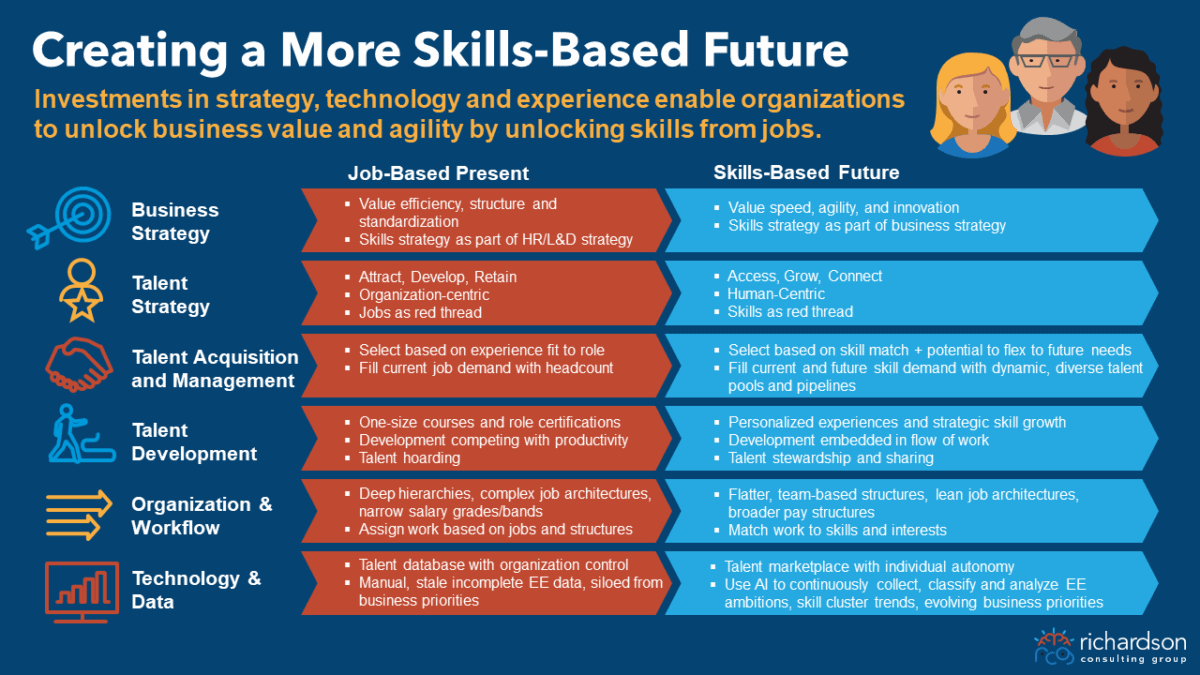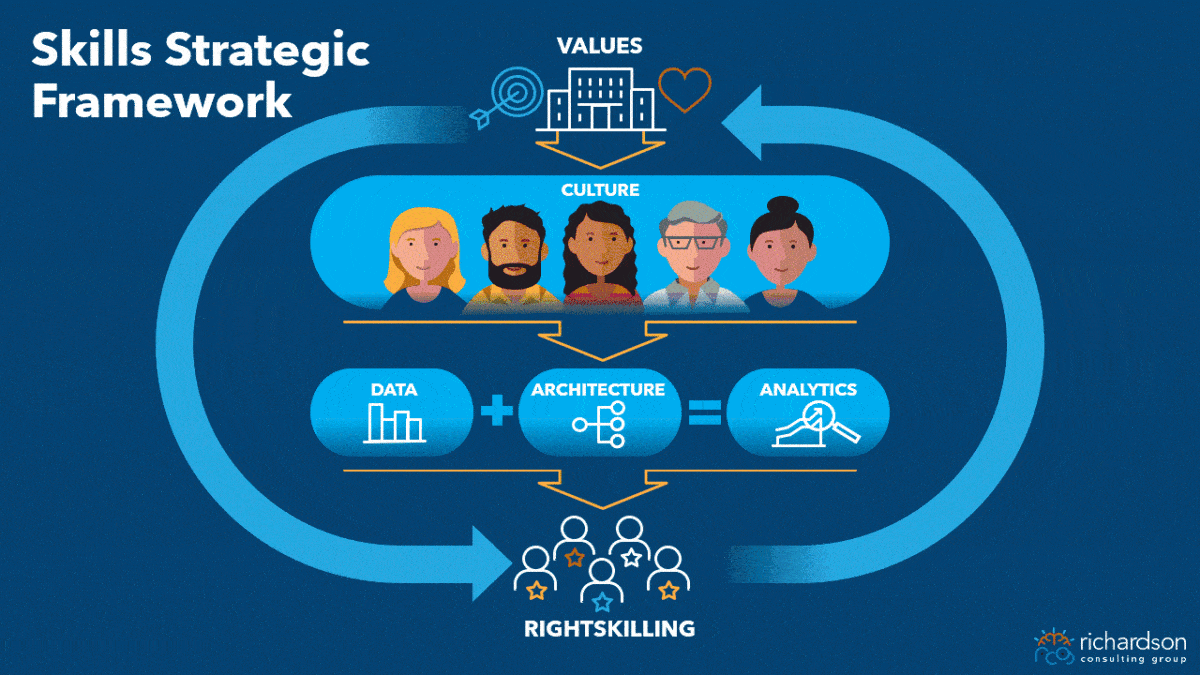
Greetings, fellow HR aficionados and talent strategy enthusiasts! Are you feeling overwhelmed by the gargantuan task of reshaping your organization from a job-based legacy to a skill-based future? If so, you are in good company.
Building a modern workforce is complex and challenging. Industries evolve at blinding speed. New tech platforms and ways of working are disrupting work design and flow. To stay ahead, we need to create a well-balanced work ecosystem that embraces skills, competencies, and capabilities.
But wait, there’s more! To truly excel, you must grasp the finer points of organization design. This secret ingredient will help you fine-tune your workflow and processes, boosting efficiency while improving outcomes.
Organization design ensures work teams are in tune and working towards similar business goals. It helps you leverage resources, manage change, and enhance inter-departmental collaboration. These are vital elements for mastering the work ecosystem.
In an era where change is the only constant, organizations need to be agile and flexible to stay competitive. That’s why an integrated approach to skills, workflow, and organization design isn’t just a good-to-have, it is a need-to-have. As the skilled HR professional, learning expert, or workforce manager you are, mastering this work ecosystem will open up new opportunities and lead your organization to new heights of performance.
Let’s dive into our experts’ skills roundtable recap, where we dissected some key concepts and principles.
Defining Skills and Skills-Based Organization
There’s no definitive definition for skills. Different industries and organizations have their own take on what constitutes a skill, competency, or capability.
We like to think of skill as a unit of proficiency. It is observable, measurable, learnable, and transferable. They are the Lego blocks for competencies and capabilities, and can be developed through learning, social, and work experiences.
Technical skills and non-technical skills might seem different, but in reality, they’re two sides of the same coin, both critical for workplace success. Technical skills, such as writing code or operating machinery, tend to have outcomes that can be observed and validated. Code works or fails. Machines produce outputs or they do not. As a result, theses skills can be taught, observed and measured objectively. Non-technical skills such as leadership, collaboration, and critical thinking, can be more open to interpretation, subjective to measure, and interdependent.
The paradigm shift in industries and job roles has turned the spotlight on transferable and relevant skills. Think of a ‘skills-based organization’ as the path to creating an agile workforce. We’re taking the focus away from jobs and putting it on skills, much like a chef might deconstruct a classic dish and put more focus on the ingredients, what they contribute, how they relate, and how they might be reconstructed into something new.

Future-of-work experts see it as the atomization of work into smaller parts to make it more flexible and adaptable. It is a strategy that cuts across business and talent lifecycles and creates benefits like business and talent agility, individualized career mobility, and personalized learning experience.

The skills strategic framework serves as the architectural blueprint for building and scaling this type of agile work environment. The key elements are:
- A strong Value Proposition that promotes leadership buy-in, manager sponsorship, and employee engagement to achieve a wider strategy adoption.
- Rightskilling, which describes strategies to get the right skills to the right place at the right time. These strategies include acquiring new talent, upskilling existing talent, acquiring contingent labor, or employing strategic automation.
- A Skills Culture that enables a skills-first mindset and skills-focused behaviors.
- Skills Data that is accurate, reliable, and visible at the individual and organizational levels.
- A Skills Architecture that is clear, consistent, and adaptable to the changing needs of the organization.
- Skills Analytics that provide accurate, actionable data on skill supply, demand, and forecast.
Tuning the Symphony of Skills, Competencies, and Capabilities
A recurring theme in our expert skills roundtable discussions is the intriguing interplay between skills, competencies, and capabilities.
Defining these terms consistently, and differentiating between them, can feel like conducting an orchestra while each musician plays in a different key. Case in point: in one session, representatives from two organizations gave almost opposite definitions of “skills” and “competencies”, with one having skills as a part of a competency, and the other the reverse.
It is easy to lose the plot, but let’s not forget why this conversation is crucial. Nailing these definitions shapes our approach to data collection, and informs how we present insights to business leaders.
For Gordon, our skills guru from a skills consultancy, skills are rooted in knowledge, while performance springs from execution.
“In skills conversations, the difference between skills and performance is pivotal. Skills represent the capability to execute a task, while performance showcases the consistency and quality of that execution over time.”
In other words, ‘capability’ and ‘consistency’ aren’t identical twins. An individual might possess exceptional capabilities but lack the motivation to perform consistently. These are unique signals that ought to be read differently. It’s like comparing the recipe you have (capability) to the meal you actually cook (performance).
Adding to this perspective, Daisuke, Director of Product Management and Marketing, emphasizes the influence of the emerging skills economy. Platforms like Upwork and Dribble let you search for talent based on skills, thus deconstructing roles or jobs into individual skills.
“So, competency revolves around performance, while skills are more about unbundling jobs into specific units.”
For Sanjay, a partner at Kanso Design, the terms are intertwined and fluid, morphing depending on the role. One person’s competency could be another’s capability or skill.
“Certain skills are expected for specific roles or positions. However there are fundamental skills that you should carry in your career portfolio, accumulated from previous roles, current duties, or specific training and certification.”
A clear understanding of these distinct requirements becomes the key to solving the proficiency assessment puzzle.
Despite the varying perspectives, we gained agreement on a shared definition during our roundtable. We decided to view ‘skills’ as the fundamental building blocks of proficiency and a piece of the larger competency and capability puzzle, the other pieces being knowledge behaviors, abilities, results, and other performance measures. It’s not a definitive answer, but it’s our harmonious consensus—for now.

Focus on Key Metrics and Actionable Insights
The path to a skills-based organization is a winding one. Where does one find the key to untangle skills from defined roles and job descriptions? Can we find a sweet spot that strikes a balance? How can we best navigate the transition? To these questions, Sanjay offered an intriguing prompt.
“I’d like to understand perspectives on skills vs defined roles and job descriptions. Additionally, how are an organization’s strategy, operating model, and design shaping its ability to craft a robust capability and skills foundation?”
He underlines the surging discussion around skills, noting their double-edged advantage: amplifying an organization’s capabilities and empowering employees to enhance and progress their careers. Businesses are gently transitioning from a job-based present to a skills-based future. It is a delicate dance, a fusion of past practice and future aspirations.
Sanjay’s question revolves around understanding how well organizations are adopting the skills-based trend. At the moment, it appears as if businesses are hopping onto the skills bandwagon much like they embraced Agile and Digital Transformation. But is it just a transformation-of-the-month, or is this a more durable shift to a new workplace reality?
Gordon chimes in, reminding us that the concept of skills-based organizations isn’t exactly fresh off the press – it has been around for over three decades. The problem? It hasn’t been tangible or accessible, primarily due to the herculean task of pinpointing skills through job and task evaluation. The future, he suggests, will see skills becoming more outcome focused. The spotlight will shine on the result of a task well-performed rather than the job or role definition.
Cue the advent of terms like ‘liquid workforce’ and ‘gig economy’. Unlike the much-hyped ‘death of performance reviews’, the buzz around skills isn’t just hot air.
Gordon envisions a future where our focus will zero in on tasks, deliverables, and outcomes, rather than simply cataloging skills. The goal isn’t merely to atomize work into a comprehensive skills list, but to have tangible evidence of achievement.
Another factor at play? Businesses swinging between the poles of fear and greed – a constant struggle to mitigate risk, curb expenses, and chase revenue growth. The alignment of these factors via work output and the skills required to achieve them becomes the ultimate destination.
Drawing a parallel to the evolution of e-learning, Gordon suggests a similar trajectory for the skills-focused shift. E-learning was initially touted as a way to put all learning online and make it accessible, scalable, and self-paced. But it didn’t fulfill its promise. The pendulum initially swung to the extreme, but traditional in-person and cohort-based learning models remained, giving rise to the 70-20-10 learning model. Now, enterprise learning teams are more focused on a more blended, balanced approach of the right thing at the right time for the right person based on their learning and performance goals.
In much the same way, skills won’t revolve around a one-size-fits-all standard driven by one or a few vendors. With time, the vendor-driven standards will fade in importance, and there will be a more dynamic understanding of skills.
In other roundtables, we’ve learned there are different skills-based adoption patterns across industries and functions. Tech firms and IT departments, for instance, that have adopted Agile practice, tend to find skills-based approaches complement practices they have already adopted like continuous learning and adapting workflow to fit available skills. For them it is less a leap than a next step.
However, other sectors tread with a bit more caution, maintaining a firm grip on workflow control and predictability. Their caution isn’t without rationale – it’s driven by goals like safety, resiliency, and reliability.
Orchestrating Skills Strategy: The Role of Organization Design and Operating Model
A skills strategy is not developed in isolation. It’s not about assembling a team to fit a laundry list of skills, or stuffing a digital learning platform full of content linked to skills and crossing your fingers. Hope is not a method. It is about forming a thought-out strategy, a clear purpose, and creating genuine value.
The real secret ingredient? Understanding how your organizational design and operational model can make or break your skills strategy.
Understanding these interdependencies is crucial for creating a strategy that works. And from Sanjay’s perspective, most people don’t.
He referenced a recent conversation with a client who is a Global Director of Talent. The client confessed they were planning to eliminate jobs altogether and recruit purely based on skills.
Sanjay emphasized that such a change hinges on the organization’s strategy and design. Swapping job-based recruitment for a skills-only approach necessitates a fundamental shift in your operating model, impacting everything from hiring to resource management, and the way you organize and design work.
It is not as simple as deciding you want to hire someone because they’ve got a certain set of skills. At the individual level, people still want to do a job. They crave the sense of fulfillment that comes from deploying a set of skills that they’re passionate about, or particularly adept at. And for teams to flex work to skills, they need to establish ways of working and channels of communication that support the workflow.
A shift from hiring generalists to selecting individuals with specific skills, may be the right approach in a growing number of cases, but strategically aligning skills with organizational needs is crucial. For skills-based hiring to work, you must put it in the context of your operational and organizational design.
A growing number of platforms offer skills clouds, ontologies or taxonomies with thousands or even millions of skills. These are valuable as a starting point, but to be effective, organizations need to curate and adapt these models to their specific needs. Most organizations don’t yet have the governance process and structure to support it. This is part of the bigger, ongoing skills-based organization conversation happening now.
Gordon added that he does not know an organization that is skills-based from end-to-end. It tends to be certain functions or particular use cases.
“The over-atomization of skills won’t do us any favors. It’s about skills in relation to other skills and what they can collectively deliver.”
The study of skills is not a precise, atomic science; it’s not about breaking things down to their smallest components. Skills exist in the context of creating work product, delivering services, and solving problems. While skills is a hot topic of discussion, no organization has completely nailed it, and what works in one organization may or may not transfer to another.
As a senior leader from Mercer, John Boudreau puts it, we need to zoom out from the atomic level, since skills are useful in combination – as in a molecular compound. It is the combination of skills that deliver real, tangible outcomes, not the standalone value of a single skill.
Mastering the Work Ecosystem: One Step at a Time
Mastering the intricacies of the work ecosystem requires a deep understanding of not just skills, but also workflow, business outcomes, and organization architecture. The best strategies pivot around these core themes.
Our advice? Start small, simple, and soon. Start somewhere with a tangible, preferably urgent business need and launch your skills journey from there. Remember, the work ecosystem evolves, it grows, and it shifts. Every change in strategy, organization, or market conditions creates demand for different skills applied to different needs. Being adaptable is not optional; it’s a necessity. Stay in tune with the industry’s pulse, fine-you’re your workflow designs, embrace the strategic use of technology and automation, and build a culture of continuous growth and improvement.
Want to deepen your understanding of how other organizations are creating a more skills-based future? Join us at an upcoming roundtable session to exchange thoughts with other experts and build your network of like-minded professionals. For a deeper dive on a specific challenge, you can also schedule a one-on-one session with me.
